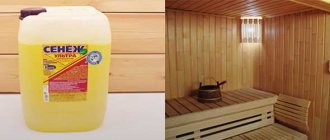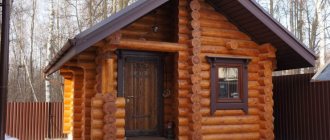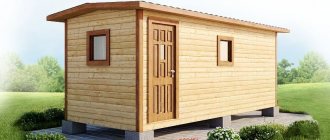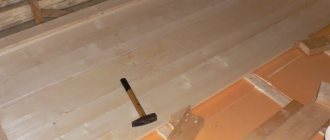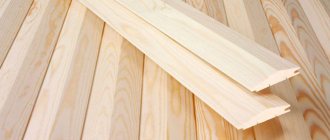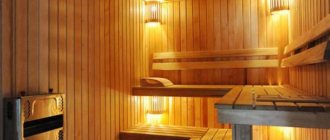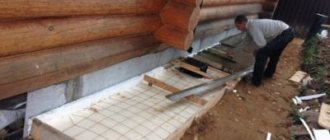- Options for lining for a steam room
- Choosing a lining for a waiting room
- Lining for walls outside the bathhouse
- Criteria for choosing lining
- How to process lining
- Types of lining for a bath
- Calculate the area of the internal lining
- Panel selection table
Wooden lining is considered the best finish for a bathhouse. This is an environmentally friendly material that creates a favorable microclimate in the room.
Wooden paneling for sauna
Choosing a lining for a waiting room
In this room the temperature and humidity are lower than in the steam room. Therefore, for finishing you can use wood of any species, incl. and conifers. They will give off a pleasant aroma. The lining made from pine is cheaper, the more expensive is the one made from birch, aspen or linden.
If you plan to cover not only the walls of the dressing room, but also the ceiling, it is recommended to take material from wood of the same species. There is no need to coat the surface with varnish or paint. But in order to protect it from moisture and pests, an antiseptic is used. It is also used for wood that will be used to sheathe the steam room. In addition, the material is impregnated with fire retardants to increase the level of fire safety and extend the service life of the products.
The undeniable advantages of aspen
This type of wood is deciduous and has a fairly high density, about 490 kg per cubic meter. Aspen is a worthy competitor to coniferous wood, has unique characteristics, and, of course, its moderate price is an undeniable advantage. Thanks to all these qualities and many others, lining made from this material is in demand among consumers and is a favorite material of craftsmen.
Everyone will agree that a bath should not only tone up, but also relieve tension and relax. And it is deciduous trees, such as aspen and linden, that will give such a result. A bathhouse lined with panels of such species will increase the relaxing effect of bathing procedures.
Aspen has unique advantages, first of all, it is the smell; the aroma of the wood of this species fills the bathhouse with a fresh, bitter spirit of health. Well, and secondly, but not least - high sensitivity to air humidity - such material remarkably absorbs moisture, which creates in the steam room the effect of moisture formation not only from the surface of the heater, which was doused with liquid, but generally from the entire area of the wall.
Of course, when choosing material for cladding, quality should be the main priority. It is much better to purchase high-quality lining from inexpensive wood than to buy more expensive linden, but of lower quality. Low-quality and insufficiently dried material will lead to the fact that in a couple of years you will have to change some cladding elements, or, well, replace all the panels.
Lining for walls outside the bathhouse
It is customary to clad the premises in the bathhouse with wood. But this material can also be used for external cladding. However, higher demands are placed on it, since the aggressive influence of the external environment is great.
According to the profile shape, “American” or “block house” is more often used, i.e. imitation timber. As for the type of wood, coniferous or aspen are suitable.
Wooden lining for a bath
Which tree is better
Aspen - as the best panel for finishing a bath
Local traditional raw materials for lining are oak, linden, aspen, alder, poplar, and pine.
Each tree has excellent properties (more details here). Many consumers choose aspen, and here's why:
- after processing and drying, a very durable product is obtained, no worse than oak . In terms of resistance to splits and cracks, it is superior to poplar, coniferous trees, maple, beech, and walnut;
- the wood is moisture resistant and retains its natural color for a long time;
- during initial processing it is soft and pliable (like linden lining);
- does not emit resins unlike conifers;
- due to low thermal conductivity, walls, shelves, benches made of aspen do not burn the body;
- cheaper than many of its competitors with similar properties, since it is more accessible and less demanding when grown.
In many characteristics, aspen products are close to linden . The differences are in favor of the former: the source material is less friable, the consumption period is longer.
The wood is endowed with antiseptic properties, as a result of which aspen sauna lining is not damaged by fungi and harmful bacteria do not multiply on it. The treated wood is practically not susceptible to putrefactive processes.
Since ancient times, the aspen tree was considered capable of relieving a person of pain, fatigue, and negative energy. Lining the inside with such material increases the healing power of a steam bath.
Some shortcomings (blackening from prolonged exposure to moisture, rot inside the barrel) do not detract from the popularity of this material.
Types of lining
There are different types of lining. The choice depends on several factors: where it is installed indoors, whether it is used for outdoor work, what the climatic conditions are in the region, etc.
Eurolining
Types of eurolining have a common feature - the presence of ventilation gutters, which are located on the back side of the panel, in the longitudinal direction. They provide an outlet for moisture that collects on the walls of the bathhouse. If you do not provide a ventilation system, the material will “lead.” And here the ventilation is already there, no additional work will be required.
Eurolining
Lining - "quarter"
The lining is also made of wood, but a quarter is used on the back and front sides. This design feature is considered the main advantage, since it facilitates installation - it will not be possible to connect such boards incorrectly. However, the material is not suitable for exterior finishing of a bathhouse, since there is no tongue-and-groove connection.
The lining can only be installed horizontally: when laying vertically, it is impossible to connect the lamellas with a sufficient degree of strength.
Quarter paneling is not as popular as it used to be. It does not provide a tongue-and-groove connection. Under the influence of temperature and high humidity, the coating can diverge greatly.
Quarter paneling
American lining
This is a universal variety. It is used mainly for the outer cladding of the bathhouse. The difference between the lining is the shape of the lamellas - an irregular triangle.
The end of the panel, which is larger, is equipped with a groove designed for mounting a narrower end. “American” can be laid with an overlap. This helps protect the joints from environmental influences.
At the same time, the flat front side of the “American” looks like a beam, which makes it attractive.
The difference between this lining is its massiveness. The width is at least 14 cm and the thickness is at least 2 cm.
American lining
Block house lining
The difference is the rounded front side, which allows you to imitate a rounded log. There is a tenon at the top of the lamellas and a groove at the bottom. “Block house” is made not only from natural wood, but also from metal or polymers. Any of the materials is suitable for the exterior decoration of bathhouse walls.
The advantage is the accuracy of the geometry, which simplifies and facilitates installation work.
Block house lining
"Peasant" paneling
This is how standard lining is called for its simplicity of design, since it is characterized by smooth and flat panels.
This is a practical and convenient finishing material. Thanks to a shorter tongue (compared to other types), the “peasant” lamellas are connected tightly, thanks to which you can get a solid wall with virtually no gaps.
"Peasant" is suitable for exterior decoration in regions with high wind loads. It provides the building with protection from cold air flows.
Peasant paneling
Imitation timber block house
This lining is a block house. Some manufacturers just call it imitation timber.
Lining imitation timber block house
Installation
Sheathing a steam room with your own hands is quite simple if you do everything according to the rules and do not deviate from the installation instructions for this particular finishing material. You should not violate installation technology, since the profile, if installed incorrectly, will quickly become unusable.
Although the aspen profile has a high level of moisture resistance and has a considerable margin of safety, this will not save the panels, if installed poorly, from rapid wear of the material. To avoid negative consequences, a number of necessary requirements must be met:
- Mandatory gap between the profile and the wall to ensure ventilation;
- If the wall is subject to moisture or is itself damp, then it is necessary to treat such a wall with a moisture-proof solution;
- Impregnate the wooden planks of the sheathing generously with primer to prevent the appearance of rot and bark beetles. Also, the sheathing should be impregnated with a fire retardant compound;
- The profile is also treated with protective solutions, after which it must be dried in the yard or on the balcony, and then the panels are put into a steam room - a day before the start of work. During this time, the lining adapts to room temperature and, in general, to the atmosphere of the steam room. This condition must be met to avoid deformation of the panels after installation due to significant temperature differences.
The lining can be installed in three ways: horizontally, vertically and diagonally. The preparation of the walls will depend on which installation method you choose.
Another thing is important: no matter how you install your panels, the sheathing should be positioned perpendicular to your profile.
Laths for sheathing are selected based on the quality of the walls; as a rule, a lath with a cross-section of 40x20 mm or specialized metal profiles are used. If it makes sense to increase insulation by adding a layer of insulation, the slats can be thicker. A distance of at least 400-500 mm must be maintained between the guides. The length of the guide must correspond to the height or width of the walls, it depends on the installation method (horizontal or vertical). If the guide is shorter, the length is increased with an additional beam, the main thing is that the beam is in line with the butt rail.
The sheathing is fixed to the wooden wall with self-tapping screws, but if you have a brick or stone wall, then you need to use dowels. Additional bars are attached around window and door openings, to which platbands and wooden panels are mounted. Holes for sockets and other decorative inserts, as well as for various fasteners, are drilled using a drill attachment - a crown.
After installing the sheathing in your steam room, it is highly recommended to coat the decorative areas of the surface with wood varnish. This procedure will not only significantly improve the appearance of your steam room, but will also significantly increase the service life of the material you have chosen.
Some people use paint instead of varnish, but in this case the unique texture of the wood itself is hidden. The panels should be varnished every year, or at least once every three years. In this case, your profile will be in excellent condition for a long time.
It is important to understand that varnish is a flammable material, so after you have applied varnish to all panels, you need to cover the surface with a special fire retardant solution. Apply the solution to the surface with a roller or brush and then allow it to soak in.
The initial and final aspen panels are fixed at a distance of about 5 mm from the ceiling and walls. This is done to increase ventilation between the panels and the wall. After installing the initial and final panels, minor defects may be revealed, including hidden nail heads or screws; such defects are perfectly masked by baseboards or decorative inserts.
This cladding will serve you faithfully for many more decades; aspen reacts remarkably well to aggressive influences and will not crack, especially with proper use and proper care. Aspen lining for a bathhouse leaves only positive reviews from craftsmen who have dealt with this material, and this material is also widely in demand among modern consumers.
Calculate the area of the internal lining
It is necessary not only to choose the type of lining, but also to make the necessary calculations in order to buy the required amount of material (with some margin).
The area taken into account is not the area of the room, but its walls, and sometimes the ceiling, since lining is not used for the floor.
For example, a bathhouse consists of 2 rooms. The area of the steam room is 3x2 (m), and the area of the dressing room is 3x1 (m). At the same time, the ceiling height is standard - 2.5 m.
Then the following algorithm is used:
- The area of 2 walls of a steam room 3 m long is 3 x 2.5 = 7.5 m (the total figure will be 15 m).
- The area of the short walls is 5 sq.m., and the total area is 10 sq.m.
- The area of the ceiling covering is calculated as 2x3=6 m.
- To finish the steam room, the lining should be 15+10+6=31 sq.m.
A similar algorithm is used for the waiting room. With the given values of material, you need to buy enough to be enough for another 23 sq.m.
Wooden lining for a bath
How to take measurements correctly
To buy the required amount of lining, you will first have to make accurate measurements - this is the only way to make calculations.
To do this you need:
- Measure the length, width and height of the walls in the steam room and dressing room.
- Mark the location of the oven. For fire safety reasons, the walls near it are finished not with clapboard, but with tiles or natural stone (the width of such a zone should be at least 40 cm).
- Calculate the planned insulation thickness.
After taking measurements, you need to decide what type of installation to implement - vertical or horizontal.
For example, the ceiling height is 2.5 m, and the vertical method is chosen for finishing. Then you need to look for lining 2.5 m long. The walls will be finished with such panels. When covering the ceiling, their length depends on the width of the room. With the horizontal cladding method, they look for material whose length is equal to the width of the wall: in the example above it is 3 m.
A bathhouse almost always needs insulation. Therefore, measurements are taken taking into account the installation of the frame and the thickness of the insulation.
Lining area (square meters)
When purchasing material, it is better to enlist the help of a specialist who can help you calculate the required amount of material. Or you will have to do additional calculations yourself, since products are sold by cubic meters, and the required area for covering is calculated.
There are special tables that indicate how many square meters of lining are contained in 1 cubic meter of material. Moreover, the length of the products is taken into account. For example, with an indicator of 3 m in 1 cubic meter - 278 boards of size 96x12.5 mm. A specialist will help you perform more accurate calculations.
Price overview
The cost of aspen lining depends on the specific manufacturer and category of the selected board. Also, prices may vary slightly in different localities. The coating is sold in factories, construction markets and stores.
Photo - packaging
The lining is often sold in packs of 10 boards each, the sheets are insulated against each other with protective film or cardboard. Price for Extra category packaging, length 1 meter, thickness 15 mm, width 85 mm (one package is enough to cover 1 square meter):
| City | Price, y. e. | City | Price, y. e. |
| Moscow | 7 | St. Petersburg | 7 |
| Ekaterinburg | 6,5 | Bryansk | 6 |
| Vologda | 6 | Irkutsk | 6,5 |
| Kirov | 6 | Kostroma | 6 |
| Nizhny Novgorod | 6,5 | Novosibirsk | 6 |
| Omsk | 6,5 | Petrozavodsk | 6 |
| Pskov | 6 | Samara | 6 |
| Tver | 6,5 | Tomsk | 6 |
| Tyumen | 6 | Ufa | 6 |
| Cherepovets | 6 | Yaroslavl | 6 |
Very well-known manufacturers of aspen lining in St. Petersburg and Krasnoyarsk are LenWood, Stremula and MagaSauna. These companies not only guarantee high quality products, but also provide free delivery of lumber for wholesale purchases.
August 24, 2015 Author: Vladimir Bakaev
